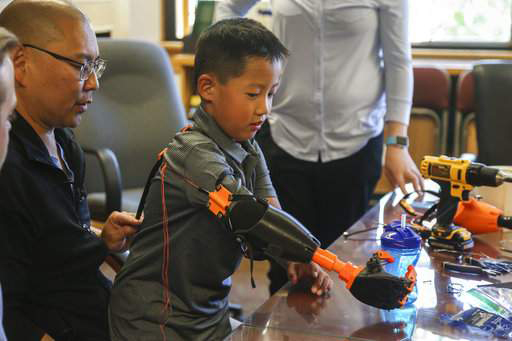By LYNNE TERRY

Jude Rochon practices picking up a water bottle with his new prosthetic arm made on a 3D printer by Dr. Albert Chi. (Photo by Stephanie Yao Long)
PORTLAND, Ore. (AP) — A Portland trauma surgeon needed unusual tools for the operation: a glue gun, aluminum foil, plastic wrap, and orange string.
Dr. Albert Chi even called out for scotch tape as if asking for a scalpel.
The tools, plus a few assistants and plenty of patience, is what it took to assemble, adjust and tinker with a 3D prosthetic hand and forearm for 6-year-old Jude Rochon at Oregon Health and Science University.
The Astoria boy was born with a left hand, but no right hand.
With his new limb, he was able to stab a colorful putty potato with a fork and hold an iPhone, sending a rainbow and other emojis to his mother. He also fist-bumped his 11-year-old sister, Mia, with his right arm for the first time.
“It’s a big deal,” Chi said, “a very big deal.”
The device is the first 3D prosthetic made by an Oregon hospital. Designed by Chi, it’s also unique. Other 3D arms are operated by the wrist or elbow. This one uses a harness, something other designers haven’t been able to make work. It’s powered by the opposite shoulder, giving Jude free use of his right elbow.
Chi gave Jude two forearms. They’re both essentially the same but one starts in a closed-hand position and the other starts in an open-hand position. He can swap them, depending on what he wants to do.
The devices are made of 20 to 30 orange and black 3D-printed parts — colored for the Oregon State Beavers, Jude’s favorite team.
When he leaned forward, the open hand closed around a plastic drinking container. Chi put the closed hand on Jude and showed him how to wrap it around the right handlebar of a scooter.
The young boy didn’t say much but beamed as he got on the scooter, a gift from OHSU, and rode down a slick hallway in the surgeon’s department. He’ll now be able to take part in sports — something he hasn’t ever done — and play on the monkey bars.
“It’s pretty amazing,” said Mike Rochon, the boy’s father. “It looks like he’ll be going zip-lining.”
Traditional prosthetic limbs run as high as $100,000, but this one was free.
The first 3D-printed prosthetic arm by an Oregon hospital
To make Jude’s forearm, Chi donated his time. He obtained a free design from an open-source prostheses group, Enabling the Future. He redesigned it to add the shoulder harness, fitted it to Jude and supplied the $50 worth of materials — basically plastic, string, buckles and elastic — for free.
“It’s a labor of love,” Chi said. “It’s so moving.”
The June 22 fitting took a few hours, requiring some last-minute adjustments. Chi brought in two volunteer assistants to help with the assembly: pre-med student, Isaac Womack and 13-year-old West Sylvan Middle School student Luci Giles.
Jude’s father took a video and his mother snapped some photos as they watched with their other son, Sawyer, 9 and Mia.
“This whole thing has been such a gift,” Alivia Rochon said.
The Rochons adopted Jude from an orphanage in Shanghai, China, five years ago. At the time, they wanted a bigger family. Health issues pushed them toward adoption. A variety of circumstances led them to a special needs group in China. The group recommended Jude.
It was a fit from the start. “As soon as I looked at his picture, I knew he was our son,” Alivia Rochon said.
She wondered what his missing limb might mean going forward, how much help he would need. But Jude adapted, she said.
“He just amazes me all the time,” Alivia Rochon said.
“Some things may take him longer or he does them differently — he figures out a way,” she said. “He’s the most determined kid I have met in my life.”
But this past year, the Rochons watched his confidence fade as he was bullied in first grade. He told his parents others didn’t want to play with him because of his missing forearm.
The couple started researching prosthetic options late last year.
Serendipity connected them to Chi, a surgeon and engineer hired by OHSU last August. A nurse at OHSU, a friend of Alivia Rochon’s sister, talked to Chi about Jude.
He called Alivia Rochon. He wanted to help.
Before OHSU, Chi worked at Johns Hopkins University in Baltimore developing prosthetic limbs. They include bionic arms controlled by thoughts. He was also one of the first volunteers to join Enabling the Future.
The nonprofit grew out of a large mechanical hand created in 2011 by Ivan Owen, a puppeteer in Arlington, Washington. Owen ended up making a 3D hand for a boy in South Africa and put the design online for free.
Enabling the Future now has many tested designs online that can be accessed by anyone worldwide.
The organization has created several thousand limbs for children and adults in 80 countries, said Jen Owen, the puppeteer’s wife.
The technology isn’t yet ready for making prosthetic legs, which require sturdier material than 3D printers can now use, Chi said. They also don’t have electronic devices like traditional prosthetic arms and hands.
“That is the next phase,” Chi said.
It will take Jude weeks or months to adapt to the prosthetic. In about 18 months, he’ll need a bigger device.
“I’ll just reprint him an arm when he outgrows this,” Chi said.
The 3D forearm is meant as a gateway device. When Jude’s an adult, he’ll probably want something more traditional than an orange-and-black prosthetic.
But for now, he’s got something all his own.
The boy dashed out the door with his family, excited to ride the scooter.
“Take it a little easy on it,” Chi said. “It’s an alpha model.”



